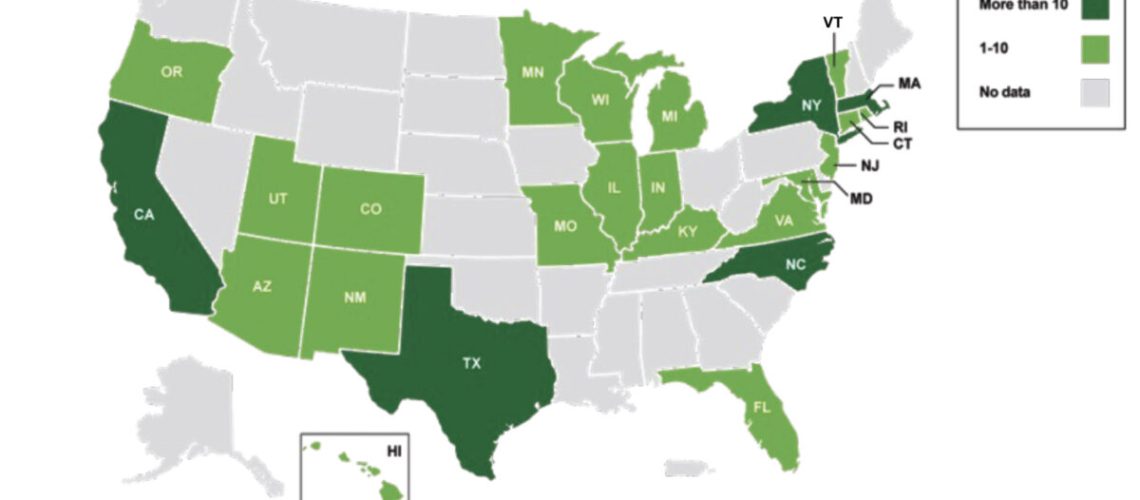With the days of solar net metering “numbered” and more utilities looking to deploy virtual power plants that compensate owners of distributed storage, industry veteran Jigar Shah sees virtual power plants as a route to industry success.
The days of the solar industry operating as a “net metering type of industry” are “starting to be numbered,” said Jigar Shah, director of the U.S. Department of Energy’s Loan Programs Office, at the RE+ 2023 conference in Las Vegas.
Now, “most solar systems come with batteries, and most are integrating smart panels,” he said. “They’re integrating demand response and load control capabilities into the inverter controls.”
Because a solar-plus-storage system with those features can earn its owner compensation through participation in a virtual power plant (VPP)—an aggregation of similar systems often managed by a third-party aggregator—Shah encouraged the solar industry to see its future in VPPs. The deployment of VPPs to date is shown in the featured image above.
Besides distributed storage, other distributed energy resources that can be aggregated into a VPP include electric vehicle chargers, smart thermostats, and smart electric water heaters.
Shah said that electric utilities are “looking to bury the hatchet and really deploy a lot of these technologies at scale” through VPPs. “Frankly, it is the only way for them to integrate all of the huge load that is coming their way,” for example due to increasing use of electric vehicles and heat pumps.
Shah separately noted that the utilities Duke Energy, serving the Carolinas, and Luma Energy in Puerto Rico have announced large VPP projects, the latter with the residential solar firm Sunnova.
Addressing the solar industry professionals in his audience at RE+, located 100 yards from a vast exhibit hall, Shah said “you’re the ones who should be integrating all of the technologies that are shown on the floor out there, into a coherent package.”
DOE investment
For its part, the Department of Energy (DOE) anticipates lending support on the order of $100 million to advance VPPs, Shah said. Sunnova’s inclusion of low- and moderate-income Puerto Ricans in its VPP project is being supported by $3 million in loan support, while other applicants are already preparing $30 million in loan requests.
DOE’s goal is for the U.S. to deploy VPPs encompassing 80-160 GW of distributed energy resources by 2030, tripling the current scale of VPPs, to “support rapid electrification while redirecting grid spending from peaker plants to VPP participants and reducing overall grid costs,” according to a DOE report released during the RE+ conference.
The savings from that scale of VPPs would be on the order of $10 billion per year due to avoided resource costs, after payments to VPP participants, said Jen Downing, senior advisor at DOE’s Loan Programs Office and the report’s lead author, at the conference. That figure is based on an estimate prepared by analysts at The Brattle Group that VPPs and time-of-use pricing combined could achieve annual savings of $13 billion by 2030. The analysis avoided double-counting of savings from time-of-use pricing and savings from electric vehicle time-of-use management.
Dynamic pricing
An alternative to VPPs for achieving flexible demand for electricity, opt-in dynamic pricing, wouldyield annual system savings of $33 to 50 billion nationwide across several scenarios, found a modeling study by Pacific Northwest National Laboratory. California is now pursuing demand flexibility through dynamic pricing.
DOE’s report says that time-of-use pricing “lacks a unifying architecture that allows the distributed energy resource aggregation to interact with a grid operator as one utility-scale resource.” The same is true of dynamic pricing.
Policies
Shah encouraged the solar industry to lobby for state policies that foster the deployment of virtual power plants. Downing described “favorable market mechanisms” in California and New York that have led to a number of VPPs in each state.
DOE’s report is titled “Pathways to Commercial Liftoff: Virtual Power Plants.” DOE has also published a “liftoff” report for long-duration energy storage, and similar reports for other technologies.



